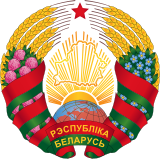Catholic Church in Belarus

| Part of a series on |
| Belarusians |
|---|
 |
| Culture |
| By regions |
| Closely related peoples |
| Religion |
| Languages and dialects |
| Topics |
The Catholic Church in Belarus is part of the worldwide Catholic Church, under the spiritual leadership of the Pope in Rome. The first Latin Church diocese in Belarus was established in Turaŭ between 1008 and 1013. In the subsequent centuries, Catholicism gradually became a dominant religion of Belarusian nobility (the szlachta) and of a large part of the population of West Belarus.
Description
According to official government data, As of 2015, there were 674,500 Catholics in the country, about 7.1% of the total population.[1] Figures in 2020 state that 10.58% of the population is Catholic.[2] Other surveys put the figure as much higher.[3]
Most Catholics belong to the Latin Church. A small minority are Eastern Catholics who worship according to the Byzantine Rite, forming the Belarusian Greek Catholic Church.
Polish and Lithuanian minorities in Belarus are predominantly Latin-Rite Catholics. The Greek Catholics are mostly ethnic Belarusians, with some Ukrainians.

The national Caritas Belarus and the four diocesan Caritas organisations are the social arm of the Catholic Church in the country.
Hierarchy
The numbers of adherents given below are self-reported by the Catholic Church as of 2009.[4]
One Latin metropolitan archdiocese:
- Minsk-Mohilev - 610,490 Catholics
Three Latin suffragan dioceses:
Metropolitan Archbishop Josephus Romualdovitsche Stanevskiej has been the leader of the Latin Church in Belarus since 2021.[5] The apostolic administrator for the Belarusian Greek Catholics is the Rt. Rev. Mitred Archimandrite Jan Sergiusz Gajek, M.I.C.[6]
History
The first Latin Church diocese in Belarus was established in Turaŭ between 1008 and 1013. Catholicism was a traditionally dominant religion of Belarusian nobility (the szlachta) and of a large part of the population of western and northwestern parts of Belarus. There was once a Ruthenian Uniate Church archdiocese in Polotsk. Josaphat Kuntsevych was archbishop from 1618 to 1623, succeeding another archbishop.
In August 2020, the leader of the Catholic Church in Belarus, Tadevuš Kandrusievič, was banned from returning to Belarus from Poland for several months after condemning violence during mass protests.[7][8] In July 2021, Alexander Lukashenko tried to intervene in the prayer schedule warning Catholic priests not to perform the religious song "The Almighty God" (Belarusian: Магутны Божа).[9]
In 2023, Freedom House rated Belarus’ religious freedom as 1 out of 4.[10]
See also
- Belarusian Greek Catholic Church
- Apostolic Nunciature to Belarus
- Catholic Church by country
- Religion in Belarus
- Freedom of religion in Belarus
References
- ^ "Religion and denominations in the Republic of Belarus" (PDF). Ministry of Foreign Affairs of the Republic of Belarus. Archived from the original (PDF) on 14 October 2017. Retrieved 17 February 2013.
- ^ The ARDA website, Retrieved 2023-08-01
- ^ Catholics and Culture website, Retrieved 2023-08-01
- ^ "Official site of the Catholic Church in Belarus. Statistical data 2009-03-01". Archived from the original on 2017-03-15. Retrieved 2010-10-18.
- ^ Vatican Press website
- ^ CatholicCulture.org website, Published 31 March 2023
- ^ Карикатура, которая будет дорого стоить: как белорусский режим делает из католиков врагов. Мнение
- ^ Belarusian Catholic Leader Returns After Forced Exile
- ^ Смотрите, нарветесь - Лукашенко предостерег от молитвы под «Магутны Божа»
- ^ Freedom House, Retrieved 2023-04-25
External links
- The Catholic Church in Belarus - official website and the central Belarusian catholic web-portal
- The Apostolic Nuntiature in Belarus
- Partał Maładych Katalikoŭ - Young Catholics of Belarus
- Sipovič, Č. (1973). "The Language Problem in the Catholic Church in Byelorussia from 1832 to the First World War". The Journal of Byelorussian Studies. III (1): 3–40. Retrieved 2 June 2024.

